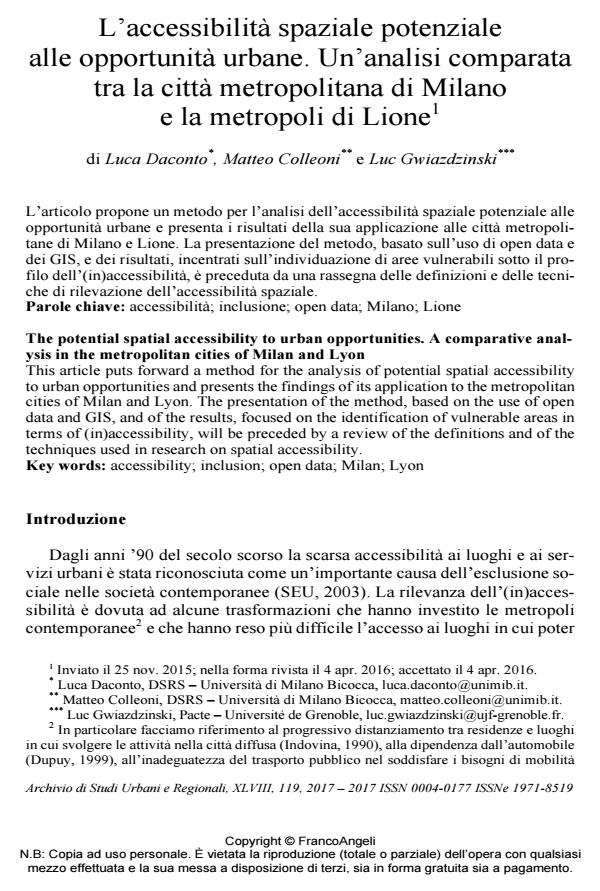L’accessibilità spaziale potenziale alle opportunità urbane. Un’analisi comparata tra la città metropolitana di Milano e la metropoli di Lione
Titolo Rivista ARCHIVIO DI STUDI URBANI E REGIONALI
Autori/Curatori Luca Daconto, Matteo Colleoni, Luc Gwiazdzinski
Anno di pubblicazione 2017 Fascicolo 2017/119
Lingua Italiano Numero pagine 19 P. 73-91 Dimensione file 198 KB
DOI 10.3280/ASUR2017-119005
Il DOI è il codice a barre della proprietà intellettuale: per saperne di più
clicca qui
Qui sotto puoi vedere in anteprima la prima pagina di questo articolo.
Se questo articolo ti interessa, lo puoi acquistare (e scaricare in formato pdf) seguendo le facili indicazioni per acquistare il download credit. Acquista Download Credits per scaricare questo Articolo in formato PDF

FrancoAngeli è membro della Publishers International Linking Association, Inc (PILA)associazione indipendente e non profit per facilitare (attraverso i servizi tecnologici implementati da CrossRef.org) l’accesso degli studiosi ai contenuti digitali nelle pubblicazioni professionali e scientifiche
L’articolo propone un metodo per l’analisi dell’accessibilità spaziale potenziale alle opportunità urbane e presenta i risultati della sua applicazione alle città metro-politane di Milano e Lione. La presentazione del metodo, basato sull’uso di open data e dei GIS, e dei risultati, incentrati sull’individuazione di aree vulnerabili sotto il profilo dell’(in)accessibilità, è preceduta da una rassegna delle definizioni e delle tecniche di rilevazione dell’accessibilità spaziale.
Parole chiave:Accessibilità; inclusione; open data; Milano; Lione
- Innovation in Urban and Regional Planning Ginevra Balletto, Martina Sinatra, Giuseppe Borruso, Francesco Sechi, Gianfranco Fancello, pp.25 (ISBN:978-3-031-54095-0)
- Smart and Sustainable Planning for Cities and Regions Filippo Accordino, Salvatore Eugenio Pappalardo, Daniele Codato, Francesca Peroni, Massimo De Marchi, pp.85 (ISBN:978-3-031-39205-4)
- Social Exclusion in Later Life Florent Cholat, Luca Daconto, pp.141 (ISBN:978-3-030-51405-1)
Luca Daconto, Matteo Colleoni, Luc Gwiazdzinski, L’accessibilità spaziale potenziale alle opportunità urbane. Un’analisi comparata tra la città metropolitana di Milano e la metropoli di Lione in "ARCHIVIO DI STUDI URBANI E REGIONALI" 119/2017, pp 73-91, DOI: 10.3280/ASUR2017-119005